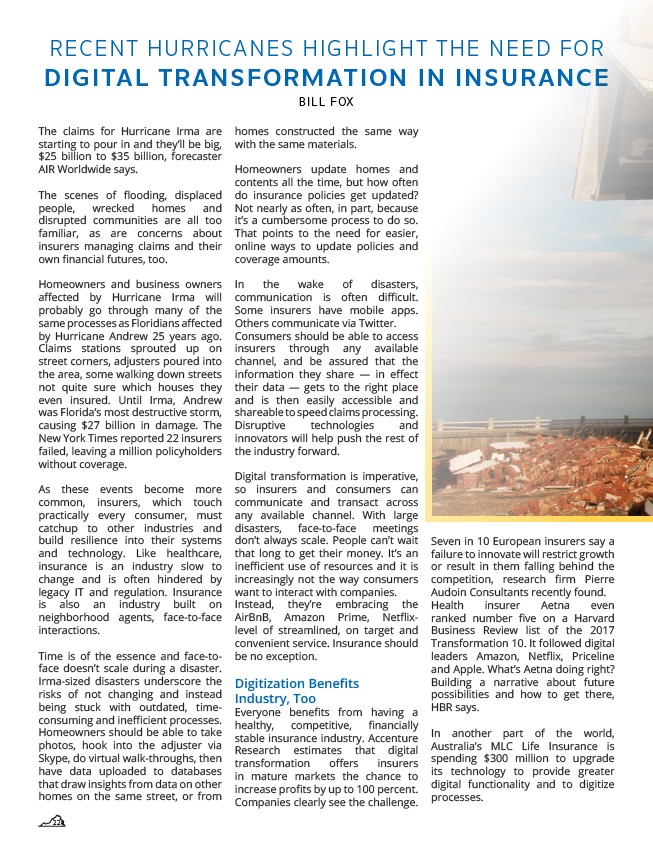
RECENT HURRICANES HIGHLIGHT THE NEED FOR
DIGITAL TRANSFORMATION IN INSURANCE
22
BILL FOX
The claims for Hurricane Irma are
starting to pour in and they’ll be big,
$25 billion to $35 billion, forecaster
AIR Worldwide says.
The scenes of flooding, displaced
people, wrecked homes and
disrupted communities are all too
familiar, as are concerns about
insurers managing claims and their
own financial futures, too.
Homeowners and business owners
affected by Hurricane Irma will
probably go through many of the
same processes as Floridians affected
by Hurricane Andrew 25 years ago.
Claims stations sprouted up on
street corners, adjusters poured into
the area, some walking down streets
not quite sure which houses they
even insured. Until Irma, Andrew
was Florida’s most destructive storm,
causing $27 billion in damage. The
New York Times reported 22 insurers
failed, leaving a million policyholders
without coverage.
As these events become more
common, insurers, which touch
practically every consumer, must
catchup to other industries and
build resilience into their systems
and technology. Like healthcare,
insurance is an industry slow to
change and is often hindered by
legacy IT and regulation. Insurance
is also an industry built on
neighborhood agents, face-to-face
interactions.
Time is of the essence and face-to-face
doesn’t scale during a disaster.
Irma-sized disasters underscore the
risks of not changing and instead
being stuck with outdated, time-consuming
and inefficient processes.
Homeowners should be able to take
photos, hook into the adjuster via
Skype, do virtual walk-throughs, then
have data uploaded to databases
that draw insights from data on other
homes on the same street, or from
homes constructed the same way
with the same materials.
Homeowners update homes and
contents all the time, but how often
do insurance policies get updated?
Not nearly as often, in part, because
it’s a cumbersome process to do so.
That points to the need for easier,
online ways to update policies and
coverage amounts.
In the wake of disasters,
communication is often difficult.
Some insurers have mobile apps.
Others communicate via Twitter.
Consumers should be able to access
insurers through any available
channel, and be assured that the
information they share — in effect
their data — gets to the right place
and is then easily accessible and
shareable to speed claims processing.
Disruptive technologies and
innovators will help push the rest of
the industry forward.
Digital transformation is imperative,
so insurers and consumers can
communicate and transact across
any available channel. With large
disasters, face-to-face meetings
don’t always scale. People can’t wait
that long to get their money. It’s an
inefficient use of resources and it is
increasingly not the way consumers
want to interact with companies.
Instead, they’re embracing the
AirBnB, Amazon Prime, Netflix-level
of streamlined, on target and
convenient service. Insurance should
be no exception.
Digitization Benefits
Industry, Too
Everyone benefits from having a
healthy, competitive, financially
stable insurance industry. Accenture
Research estimates that digital
transformation offers insurers
in mature markets the chance to
increase profits by up to 100 percent.
Companies clearly see the challenge.
Seven in 10 European insurers say a
failure to innovate will restrict growth
or result in them falling behind the
competition, research firm Pierre
Audoin Consultants recently found.
Health insurer Aetna even
ranked number five on a Harvard
Business Review list of the 2017
Transformation 10. It followed digital
leaders Amazon, Netflix, Priceline
and Apple. What’s Aetna doing right?
Building a narrative about future
possibilities and how to get there,
HBR says.
In another part of the world,
Australia’s MLC Life Insurance is
spending $300 million to upgrade
its technology to provide greater
digital functionality and to digitize
processes.